Astronomy 10: Lecture 14
Lecture 14
Thursday, June 20th 2002. Reading: Cosmic Perspective Chapter 16 & 17
The Lives of Stars
How do you figure out the life history of stars?
How can we determine the typical history of a person?
We could watch a person live out their whole life. But that takes kinda long. We could observe people of all different ages and see what the differences are between them and put together a typical history of a person. We can do the same thing for stars. We can observe a large number of stars all with different ages and see how they differ and work out how they transition from one stage to the next.
Protostars
 The life story begins in the large, roughly spherical clouds that fill interstellar space. The clouds are composed of gas and dust (tiny solid particles of matter).
The life story begins in the large, roughly spherical clouds that fill interstellar space. The clouds are composed of gas and dust (tiny solid particles of matter).
If the cloud is dense enough its own gravity will cause it to contract. Just as a compressed gas heats up so does a contracting cloud of gas.
|
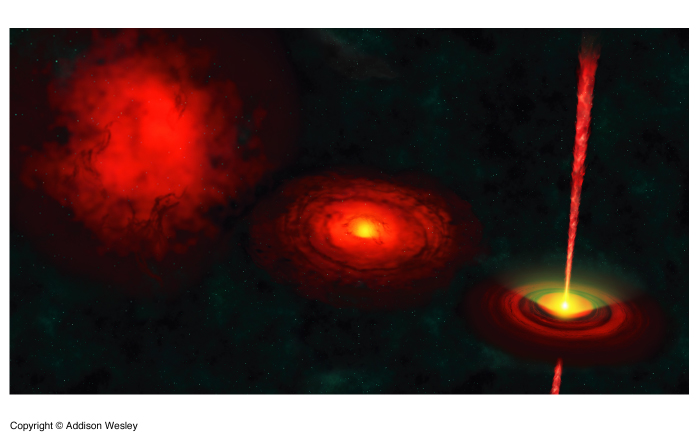 The cloud fragments into smaller pieces as it contracts, these smaller pieces continue to contract under their own weight and heat up as they go. We call these pieces Protostars.
The cloud fragments into smaller pieces as it contracts, these smaller pieces continue to contract under their own weight and heat up as they go. We call these pieces Protostars.
The time it takes for a star to contract down to the size of a star is short. The protostar phase lasts for only about a few hundred thousand to a few million years.
As the contraction continues density increases, which causes gravity to increase, which leads to more contraction, which heats up the protostar to greater temperatures.
|
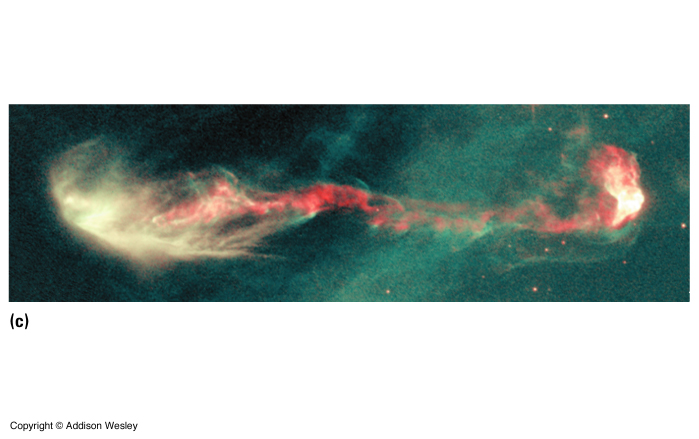
|
 When a protostar has collapses down to the point where nuclear reactions first ignite in the core we now call it a star, and find that it is located at some point on the main sequence that corresponds to its mass.
When a protostar has collapses down to the point where nuclear reactions first ignite in the core we now call it a star, and find that it is located at some point on the main sequence that corresponds to its mass.
The newborn star will have a luminosity and surface temperature now that will change very little over the course of its lifetime. So it stays put on the H-R diagram for a good long while.
|
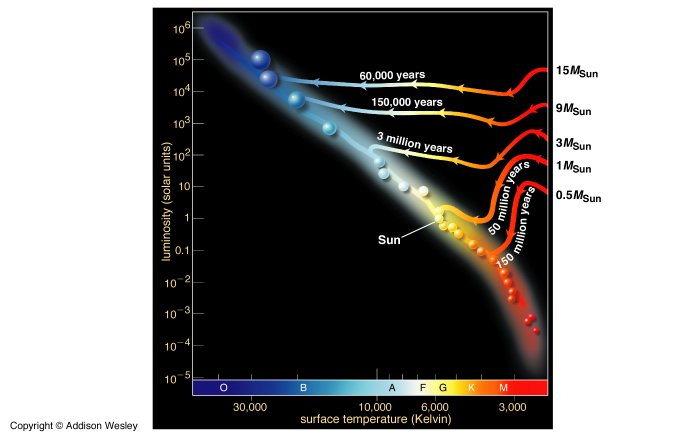
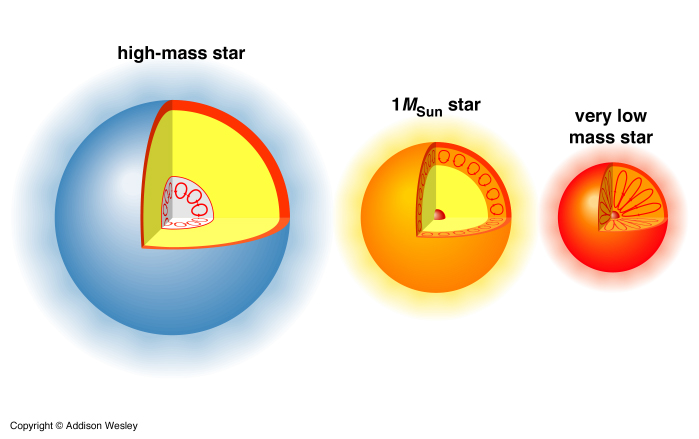
|
Death of Stars: Low Mass
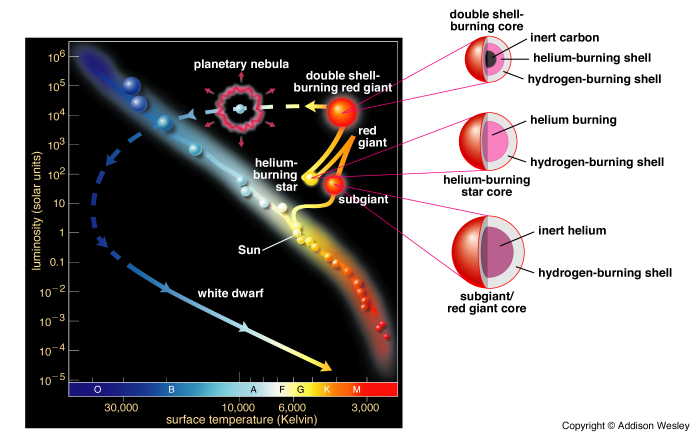 For stars with masses 0.2M
For stars with masses 0.2M < M < 4M < M < 4M (which is the majority of them) They will live quietly and contently, not changing much, for several billion years on the main sequence. (The Sun will live 10 billion years on the main sequence, it's about 5 billion years old now). (which is the majority of them) They will live quietly and contently, not changing much, for several billion years on the main sequence. (The Sun will live 10 billion years on the main sequence, it's about 5 billion years old now).
There comes a time when all of the available hydrogen in the core is used up and has been converted to helium. The core is then made almost entirely of helium. The nuclear reactions in the core stop, and the core cools.
This causes gravity to take over again (after quite a long respite) it contracts the star which will heat it again. A shell of hydrogen gas surrounding the core will then begin to heat up and reach sufficient temperature and density to start fusing hydrogen to helium.
This shell of burning hydrogen heats up the envelope of the star which increases the outward pressure which expands the envelope. The surface cools and the Star bloats up to become a Red Giant. The surface temperature is low but the star is huge and thus has a large Luminosity. Earth is fried!
|
The hydrogen burning shell rains down "helium ash" onto the helium core, thus increasing its mass and causing it to contract and heat. Eventually the helium core reaches T = 108 K and helium begins fusing
 This reaction is much faster than the hydrogen reaction and this doesn't last for very long ~ 106 years.
During this time the core can reach sufficient temperature to have the additional reaction of
6C12 + 2He4 -> 8O16 + energy
A core composed of Carbon and Oxygen forms and begins to contract because the Temperature is too low for further fusion. Just as before the contracting core will heat the envelope and cause it to expand out further making an even bigger and cooler Red Giant.
This reaction is much faster than the hydrogen reaction and this doesn't last for very long ~ 106 years.
During this time the core can reach sufficient temperature to have the additional reaction of
6C12 + 2He4 -> 8O16 + energy
A core composed of Carbon and Oxygen forms and begins to contract because the Temperature is too low for further fusion. Just as before the contracting core will heat the envelope and cause it to expand out further making an even bigger and cooler Red Giant.
|
Planetary Nebulae and White Dwarfs
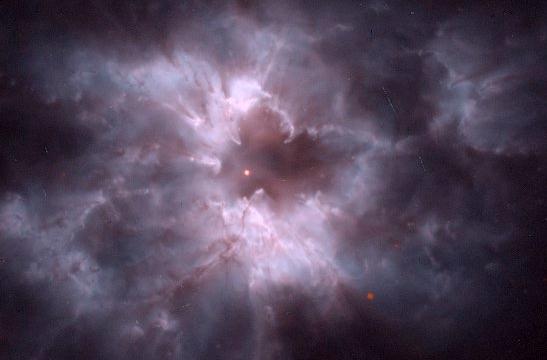 The star is now very unstable. The outer layers of the star will begin to be ejected (~ 0.2M*). The outer layers will "sluff off" forming a Planetary Nebula (they have nothing to do with planets, the name is kept for historical reasons). This is an expanding shell of chemically enriched ionized gas.
The star is now very unstable. The outer layers of the star will begin to be ejected (~ 0.2M*). The outer layers will "sluff off" forming a Planetary Nebula (they have nothing to do with planets, the name is kept for historical reasons). This is an expanding shell of chemically enriched ionized gas.
The Planetary Nebula and winds from the star will cause the star to loose mass, revealing the hot Carbon/Oxygen core. In the end all that is left behind is just this white-hot cinder (the core of the Red Giant) that is composed of mostly Carbon and Oxygen, with a little hydrogen and helium still mixed in. This is called a White Dwarf.
The White Dwarf will have a mass less than 1.4M , even if the star had 4M , even if the star had 4M when it was born. It's size is about that of Earth (R ~ 6000 km). So it is incredibly dense! If you brought 1 cm3 of white dwarf matter to the surface of Earth it would weight as much as a 1-ton truck. when it was born. It's size is about that of Earth (R ~ 6000 km). So it is incredibly dense! If you brought 1 cm3 of white dwarf matter to the surface of Earth it would weight as much as a 1-ton truck.
|
Electron Degeneracy Pressure:
What provides the pressure to hold a white dwarf up under its considerable weight? It's a quantum mechanical effect...
The electrons in the star are moving very fast, and they are prevented from slowing down (cooling down, losing energy) by a law in quantum mechanics known as the "Pauli exclusion principle". This says that no two particles may share the same quantum states. Once the lower energy states get filled (become degenerate) the remaining electrons must maintain their fast speeds and hence high temperature and pressure. This pressure provides the hydrostatic balance needed to keep gravity at bay.
The atomic nuclei (positive ions) in the star are not degenerate and are able to lose energy (cool). The white dwarf shines as the atomic nuclei cool. There are no nuclear reactions.
After about 1010 years, the nuclei cool down and the luminosity of the star becomes very low. The star is now what is sometimes called a "black dwarf". The Universe may not be old enough yet for any black dwarfs to exist. The star will still be supported by the electron degeneracy pressure and the size will remain the same.
|
White Dwarfs in a Binary System: Novae
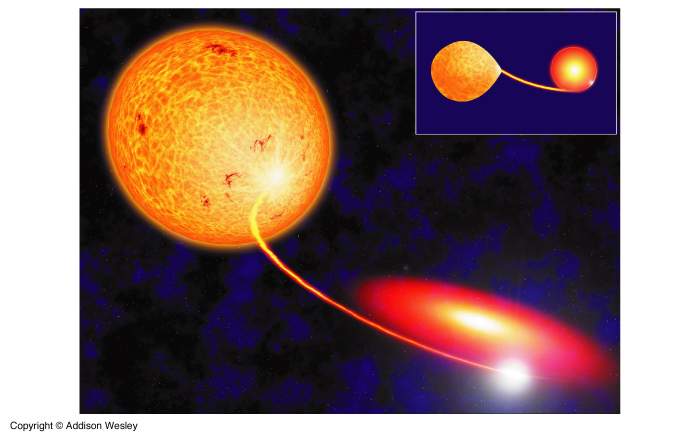 Single stars evolve in a simple manner: e.g., lifetime on the main sequence depends mostly on mass (L
Single stars evolve in a simple manner: e.g., lifetime on the main sequence depends mostly on mass (L  M4) M4)
Most stars are in binary systems and Mass exchange can occur. Two stars in orbit about each other have a "sphere of influence" about them in which their own gravity dominates, but outside that sphere the gravity of the other star becomes important. In essence stars have Roche limits just like those we talked about with planets and the formation of rings. We call these spheres of influence, Roche Lobes.
When one star bloats up into a Red Giant it can fill its Roche Lobe and the matter on the surface can be more gravitationally attracted to the companion star. Matter Flows on to the companion which in turn can now evolve faster due to the increased mass.
If the smaller companion star is a white dwarf (a long since dead star) and the other stars begins to fill its Roche Lobe (i.e., become a Red Giant), matter will flow onto the White Dwarf's surface.
It doesn't fall directly onto the surface but misses and spirals down onto it through an accretion disk.
|
 The material falling onto the surface is heated considerably by friction in the disk and the collision with the surface (very dense). This gives off much luminosity. The matter on the surface can actually undergo nuclear fusion in a great explosion.
The material falling onto the surface is heated considerably by friction in the disk and the collision with the surface (very dense). This gives off much luminosity. The matter on the surface can actually undergo nuclear fusion in a great explosion.
This explosion lifts some of the white dwarf surface away and brightens the star considerably for a short time. We witness a Nova (Latin for "new star").
The star brightens by a factor of 100 - 106 in a few days or weeks; then fades over months or years. The process can recur.
|
Supernovae: Exploding Stars
 1054 AD: Crab Supernova - seen by Chinese ("guest star"), Native American, African observers. Bright as the full Moon for several weeks. Could read by its light at night. Visible during the day.
1054 AD: Crab Supernova - seen by Chinese ("guest star"), Native American, African observers. Bright as the full Moon for several weeks. Could read by its light at night. Visible during the day.
Type I: No Hydrogen Lines visible in Spectrum, seen in all kinds of galaxies
Type II: Hydrogen Lines Visible, seen usually in the arms of Spiral galaxies only (where there are a lot of massive stars).
There are other differences as well (e.g., shape of light curve).
Previously "normal" star suddenly (~few days) becomes much more luminous (~1010L )! Rivals entire galaxy in brightness for a few weeks! Fades over months to years. )! Rivals entire galaxy in brightness for a few weeks! Fades over months to years.
|
White Dwarf Supernova
Return to the white dwarf in a binary system accreting mass from its companion. Or consider a binary system with two white dwarfs that merge.
If the mass of a white dwarf should exceed 1.4M (Chandrasekar Limit), then the star will become so hot as to begin nuclear fusion again, but this time it will not be a controlled reaction. The entire star will begin fusion all at once (no envelope above to keep it in check), a runaway of nuclear chain reactions occurs and a huge amount of energy is released all at once. The star EXPLODES and is completely obliterated. Probably takes out its companion as well as any planets left in the system from its earlier life.
(Chandrasekar Limit), then the star will become so hot as to begin nuclear fusion again, but this time it will not be a controlled reaction. The entire star will begin fusion all at once (no envelope above to keep it in check), a runaway of nuclear chain reactions occurs and a huge amount of energy is released all at once. The star EXPLODES and is completely obliterated. Probably takes out its companion as well as any planets left in the system from its earlier life.
Heavy elements are synthesized during the chain reactions from Carbon, Oxygen, and He (but there is little hydrogen in this star -- hence no hydrogen in the spectrum) and are flung out into space. (~ 0.6M of radioactive 28Ni56 is produced, 28Ni56 --> 27Co56 --> 26Fe56 + energy)
of radioactive 28Ni56 is produced, 28Ni56 --> 27Co56 --> 26Fe56 + energy)
Death of High Mass Stars
 Mass: M > 6M
Mass: M > 6M
These stars have very short main sequence lives. A 15M stars lives for only 107 years before turning into a Red Giant. stars lives for only 107 years before turning into a Red Giant.
When the star first runs out of hydrogen to fuse in its core it will behave similarly to lower mass red giants. It will first begin fusion of hydrogen in a shell around the core and the core will heat and fuse helium into carbon. There will also be carbon and helium fusion into oxygen. The star's envelope also bloats out to very large sizes (Supergiants).
The star has enough mass that when the helium supply in the core is exhausted it will shrink further and heat sufficiently to begin fusion of carbon and oxygen into higher elements. Another shell of hydrogen burning will form, and beneath it a shell of helium burning will form.
The supergiant's core will fuse very heavy elements from carbon and oxygen all the way up to Iron.
The star takes on an "onion" like structure with shells of different elements fusing into heavier elements. This all happens over a few million years tops.
|
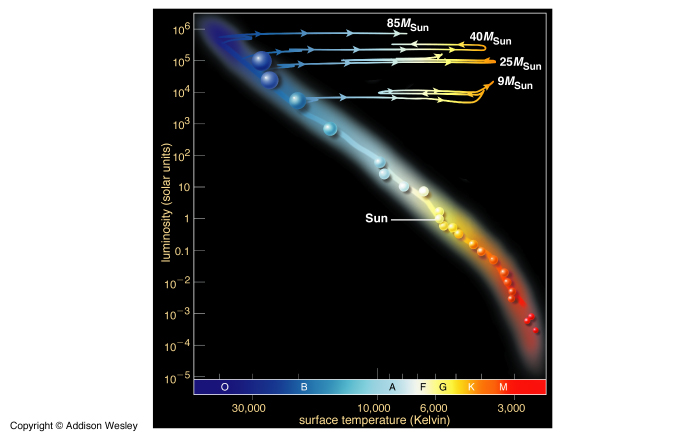
|
Massive Star Supernovae
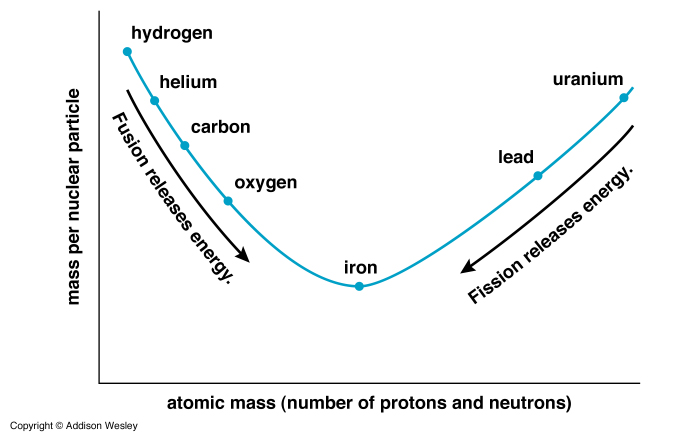 Once the core of a supergiant becomes mostly Iron the star's last hopes of fight off gravity are gone.
Once the core of a supergiant becomes mostly Iron the star's last hopes of fight off gravity are gone.
Iron is the most tightly bound of all atomic nuclei. Trying to fuse it to heavier elements will cost the star energy. (Endothermic reaction). The star cannot do this and so there will be no more nuclear reactions in the core. It continues to shrink and becomes degenerate (like a white dwarf star) The mass of the core continues to increase as matter from the fusion shells above it falls down.
|
When the mass of the core reaches 1.4M the core will collapse. Not even electron degeneracy pressure can withstand gravity's pull now. the core will collapse. Not even electron degeneracy pressure can withstand gravity's pull now.
p+ + e- --> n +  : Neutrons are formed! : Neutrons are formed!
With no pressure to stop them any longer the outer layers begin to freefall toward the core.
Outer layers bounce of the core and BANG! (actually the neutrinos do most of the work).
|

|
Supernova 1987A:
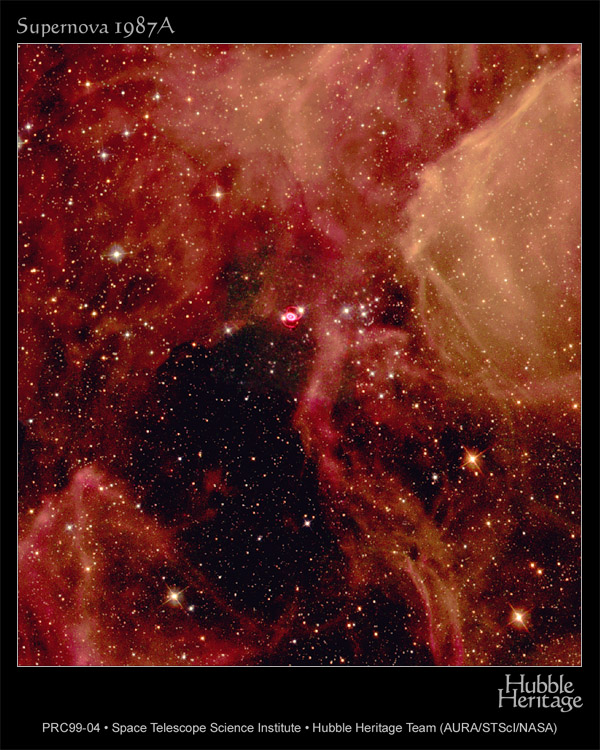

Nearby! Only ~170,000 light years away in the Large Magellanic Cloud (LMC a small satellite of the Milky Way).
- Initially was a 20M
 star (but a blue supergiant, not red - probably because LMC deficient in heavy elements to cool the surface). star (but a blue supergiant, not red - probably because LMC deficient in heavy elements to cool the surface).
- Neutrinos detected! Explosion mechanism was core collapse + rebound. Neutron star created at least temporarily.
- Total energy (emitted mostly in 1 second): comparable to energy emitted in one second by all normal stars in the observable Universe!
- >99% of energy was in neutrinos, <1% was in the energy of the ejected material, < 0.01% was in visible light!
Supernovae are the most powerful explosions in the Universe (with the possible exception of gamma ray bursters)
Nucleosysnthesis of heavy elements
In Supernova 1987A we saw gamma rays with specific energies that could only have come from short lived, radioactive Cobalt (27Co56). At infrared wavelengths, saw emission lines of freshly synthesized cobalt, nickel, etc.
Heavy elements are made in stars prior to and during explosions. They are then dispersed into interstellar space where they are incorporated into new gas clouds.
From those gas clouds new stars form enriched in heavy elements --> Planets, life.
"We are made of STAR STUFF" - Carl Sagan
|
SN Remnants
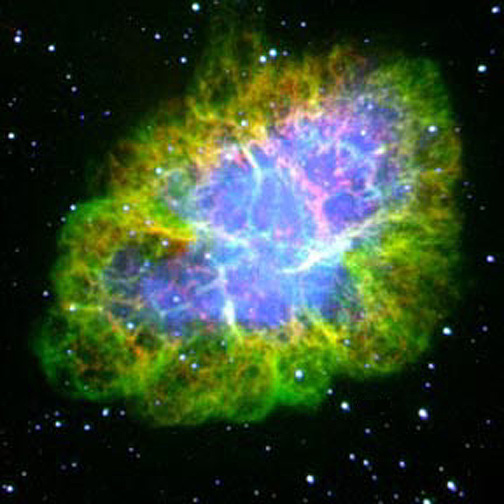 Supernova produce remnants: expanding shells of gas rich in heavy elements. e.g., the Crab Nebula. Shell initially expands at nearly 10% the speed of light.
Supernova produce remnants: expanding shells of gas rich in heavy elements. e.g., the Crab Nebula. Shell initially expands at nearly 10% the speed of light.
Cosmic Rays: high energy particles are shot out from the expanding shock wave.
Supernovas occur 1-2 time per century in any given galaxy. The last one seen in the Milky Way was in 1604 (Kepler). Gas and dust hides many from our view.
|
Neutron Stars and Pulsars
 The core left behind in a Massive Star Supernova is composed mostly of neutrons and has the density of an atomic nucleus. It is held up by neutron degeneracy pressure. Up to 2-3M
The core left behind in a Massive Star Supernova is composed mostly of neutrons and has the density of an atomic nucleus. It is held up by neutron degeneracy pressure. Up to 2-3M in a 10 km sphere! Incredible density. One cubic centimeter of neutron star material weighs as much as a mountain! in a 10 km sphere! Incredible density. One cubic centimeter of neutron star material weighs as much as a mountain!
Neutron Stars were predicted in the 1930s but not observed until 1967 as Pulsars (Jocelyn Bell): Extremely regular bursts of radio waves (e.g., P = 1.3373011 seconds).
So far hundreds have been found in the plane of the Milky Way Galaxy: Pulsars are highly magnetized and very quickly spinning neutron stars.
|
 Lighthouse Model: Very strong magnetic field channels charged particles to the poles of the magnetic field. Where they emit radiation in a beam. The axis of the magnetic field is offset from the spin of the neutron star and the beam sweeps past our line of sight so we see pulses of radio (and other wavelengths) radiation.
Lighthouse Model: Very strong magnetic field channels charged particles to the poles of the magnetic field. Where they emit radiation in a beam. The axis of the magnetic field is offset from the spin of the neutron star and the beam sweeps past our line of sight so we see pulses of radio (and other wavelengths) radiation.
A rapid pulsar (P = 0.033 sec) sits in the middle of the Crab Supernova Remnant.
NOTE: Every pulsar is a neutron star, but not every neutron star is a pulsar. Might not be "on" or might b pointing away from us.
|
Black Holes
 Neutron degeneracy pressure cannot support a neutron star having M > 3M
Neutron degeneracy pressure cannot support a neutron star having M > 3M . If during the supernova collapse the core exceeds this mass nothing known in physics can prevent gravity from collapsing the matter into some arbitrarily small volume. . If during the supernova collapse the core exceeds this mass nothing known in physics can prevent gravity from collapsing the matter into some arbitrarily small volume.
Gravity becomes so strong at the "surface" that not even light can escape: Black Hole.
|
Return to Class Notes Page
 The life story begins in the large, roughly spherical clouds that fill interstellar space. The clouds are composed of gas and dust (tiny solid particles of matter).
The life story begins in the large, roughly spherical clouds that fill interstellar space. The clouds are composed of gas and dust (tiny solid particles of matter).
 The cloud fragments into smaller pieces as it contracts, these smaller pieces continue to contract under their own weight and heat up as they go. We call these pieces Protostars.
The cloud fragments into smaller pieces as it contracts, these smaller pieces continue to contract under their own weight and heat up as they go. We call these pieces Protostars.

 When a protostar has collapses down to the point where nuclear reactions first ignite in the core we now call it a star, and find that it is located at some point on the main sequence that corresponds to its mass.
When a protostar has collapses down to the point where nuclear reactions first ignite in the core we now call it a star, and find that it is located at some point on the main sequence that corresponds to its mass.


 For stars with masses 0.2M
For stars with masses 0.2M
 The star is now very unstable. The outer layers of the star will begin to be ejected (~ 0.2M*). The outer layers will "sluff off" forming a Planetary Nebula (they have nothing to do with planets, the name is kept for historical reasons). This is an expanding shell of chemically enriched ionized gas.
The star is now very unstable. The outer layers of the star will begin to be ejected (~ 0.2M*). The outer layers will "sluff off" forming a Planetary Nebula (they have nothing to do with planets, the name is kept for historical reasons). This is an expanding shell of chemically enriched ionized gas.
 Single stars evolve in a simple manner: e.g., lifetime on the main sequence depends mostly on mass (L
Single stars evolve in a simple manner: e.g., lifetime on the main sequence depends mostly on mass (L  The material falling onto the surface is heated considerably by friction in the disk and the collision with the surface (very dense). This gives off much luminosity. The matter on the surface can actually undergo nuclear fusion in a great explosion.
The material falling onto the surface is heated considerably by friction in the disk and the collision with the surface (very dense). This gives off much luminosity. The matter on the surface can actually undergo nuclear fusion in a great explosion.
 1054 AD: Crab Supernova - seen by Chinese ("guest star"), Native American, African observers. Bright as the full Moon for several weeks. Could read by its light at night. Visible during the day.
1054 AD: Crab Supernova - seen by Chinese ("guest star"), Native American, African observers. Bright as the full Moon for several weeks. Could read by its light at night. Visible during the day.
 Mass: M > 6M
Mass: M > 6M
 Once the core of a supergiant becomes mostly Iron the star's last hopes of fight off gravity are gone.
Once the core of a supergiant becomes mostly Iron the star's last hopes of fight off gravity are gone.



 Supernova produce remnants: expanding shells of gas rich in heavy elements. e.g., the Crab Nebula. Shell initially expands at nearly 10% the speed of light.
Supernova produce remnants: expanding shells of gas rich in heavy elements. e.g., the Crab Nebula. Shell initially expands at nearly 10% the speed of light.
 The core left behind in a Massive Star Supernova is composed mostly of neutrons and has the density of an atomic nucleus. It is held up by neutron degeneracy pressure. Up to 2-3M
The core left behind in a Massive Star Supernova is composed mostly of neutrons and has the density of an atomic nucleus. It is held up by neutron degeneracy pressure. Up to 2-3M Lighthouse Model: Very strong magnetic field channels charged particles to the poles of the magnetic field. Where they emit radiation in a beam. The axis of the magnetic field is offset from the spin of the neutron star and the beam sweeps past our line of sight so we see pulses of radio (and other wavelengths) radiation.
Lighthouse Model: Very strong magnetic field channels charged particles to the poles of the magnetic field. Where they emit radiation in a beam. The axis of the magnetic field is offset from the spin of the neutron star and the beam sweeps past our line of sight so we see pulses of radio (and other wavelengths) radiation.
 Neutron degeneracy pressure cannot support a neutron star having M > 3M
Neutron degeneracy pressure cannot support a neutron star having M > 3M